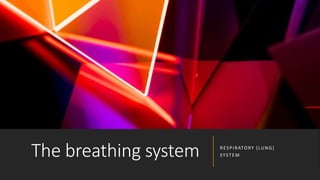breathing system.pptx
- 1. The breathing system RESPIRATORY (LUNG) SYSTEM
- 3. The intercoursal muscles, attached between the ribs, move the rib cage up and down The diaphragm is a sheet of muscle at the base of the rib cage Cillia in the nose warms the air allowing it to absorb into the blood quicker each alveolus is covered in a net of thin-walled (one cell thick) blood capillary
- 4. Alveolus structure Oxygen diffuses through the alveolus & capillary linings and attaches to red blood cells At the same time, carbon dioxide diffuses from the plasma into the alveolus Diffusion is the movement of molecules from a region of high concentration to a region of lower concentration
- 6. Preventing infection The lining cells of the nose, trachea and bronchi produce a sticky mucus that traps dust and germs White blood cells in the alveoli can engulf bacteria and foreign matters
- 7. How are the lungs adapted for their function Alveoli have a large surface area Short distance between air and blood 1 cell thick Rich blood supply Walls of alveoli are elastic
- 8. Composition of air in the lungs (% volume) Inhaled air Exhaled air Oxygen 21 16 Carbon dioxide 0.04 4 Nitrogen 79 79 Water vapour Varies saturated
- 9. Inhaling (inspiration) The brain sends signals to the rib muscles and diaphragm to contract The ribs are pulled up and out, and the diaphragm flattens downwards The volume of the chest increases Air pressure drops in the lungs More air drawn into the lungs and alveoli
- 10. Gas exchange in the lungs & tissue
- 11. Transport of oxygen in the blood Red blood cells have haemoglobin in them Red blood cells carry 97% of the oxygen The other 3% is carried in the plasma
- 12. Transport of carbon dioxide Most is carried in the plasma as bicarbonate ions or as dissolved carbon dioxide A small % is carried by the red blood cells
- 13. Exhaling The rib muscles and diaphragm relax, springing back to their original position Air pressure in the lungs increases Air is pushed out from the alveoli
- 14. Voice box Made up of two sheets of muscles Vibrates as the air passes between them Produce sounds & speech, in co-operation with our mouth, tongue and teeth We breath automatically by involuntary reflex action Controlled by medulla oblangata of the brain
- 15. Role of the brain in breathing Mostly our breathing rhythm is unconsciously set by the brain We can voluntarily change the rate at which we breath You can’t hold your breath forever Your brain won’t let you
- 16. Why can’t you stop breathing? When you hold your breath Carbon Dioxide levels rises in your blood This triggers the medulla oblangata in your brain to make you breath You end you gasping for breath
- 17. Breathing disorders Asthma – inflammation & constriction of bronchi Bronchitis Emphysema – destruction of alveoli TB – elasticity reduced (bacteria) Pneumonia – fills with fluid
- 18. Asthma Cause: narrowing of the bronchioles due to some irritant (dust mite, pollen, cold virus). Sufferer finds it difficult to inhale oxygen Prevention: removing the offending agent Treatment: inhalers
